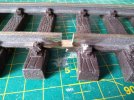Not sure if this goes in this section or track or dcc, etc..
I am looking at the Zimo MX820d to run my turnouts. I like that it is sealed.
Q1 - it says it can be triggered by an isolated track rail. How long does the rail need to be to work? I guess it also depends on how dirty the track is. Right now I am using LGB 17100 sensors. I would like to get rid of them for aesthetic reasons.
Q2 - Has anyone used one with ABC. Will this trigger the Zimo/Lenz and others, Auto Braking Control? I use the ABC diode blocks to slowly stop my trains in the station.
Q3 - If it doesn't accidentally trigger the ABC, has anyone put the rail sensor section inside the ABC block. This would determine where I have to put the sensor block.
I am looking at the Zimo MX820d to run my turnouts. I like that it is sealed.
Q1 - it says it can be triggered by an isolated track rail. How long does the rail need to be to work? I guess it also depends on how dirty the track is. Right now I am using LGB 17100 sensors. I would like to get rid of them for aesthetic reasons.
Q2 - Has anyone used one with ABC. Will this trigger the Zimo/Lenz and others, Auto Braking Control? I use the ABC diode blocks to slowly stop my trains in the station.
Q3 - If it doesn't accidentally trigger the ABC, has anyone put the rail sensor section inside the ABC block. This would determine where I have to put the sensor block.



